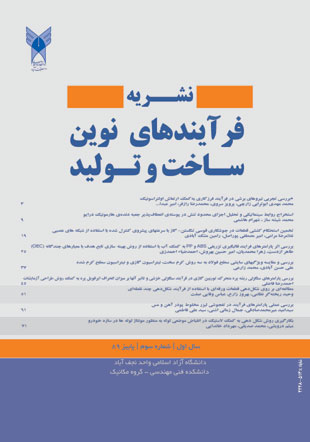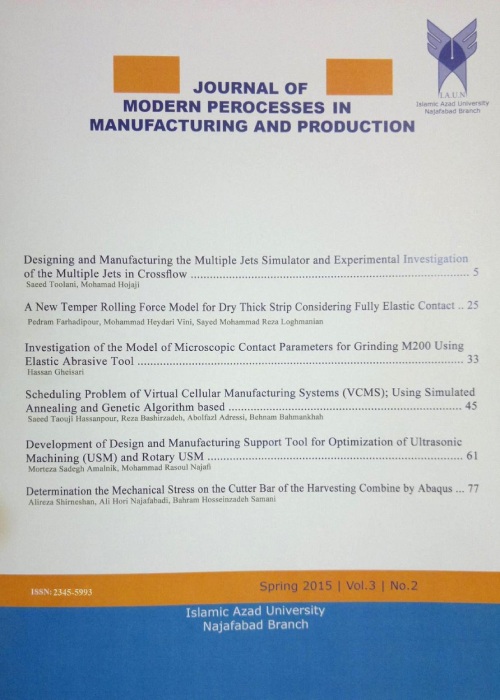فهرست مطالب

Journal of Modern Processes in Manufacturing and Production
Volume:1 Issue: 3, 2011
- تاریخ انتشار: 1390/04/01
- تعداد عناوین: 6
-
صفحه 3هدف این مقاله، بررسی نیروهای برشی در فرآیند فرزکاری بهکمک ارتعاش اولتراسونیک (UAM) بر روی فولاد AISI 1020 است. برای اعمال ارتعاش به قطعه کار، یک فیکسچر مخصوص طراحی و ساخته شده است. با تغییر عمق برش، نیروی برشی در جهت های مختلف در حالت های فرزکاری معمولی (CM) و فرزکاری ارتعاشی اندازه گیری شده است. نیروهای برشی بدست آمده از فرزکاری ارتعاشی نسبت به فرزکاری معمولی کوچکتر هستند. با افزایش مقدار عمق برش، از میزان تاثیر ارتعاش اولتراسونیک بر نیروهای برشی کاسته می شود. میانگین کاهش نیروی برشی در آزمایش های مختلف برای فرآیند UAM نسبت به فرآیند CM، 8% است.
کلیدواژگان: فرزکاری به کمک ارتعاش اولتراسونیک، فرزکاری معمولی، نیروی برشی، دینامومتر -
صفحه 9در این تحقیق روابط سینماتیکی در پوسته ی جعبه دنده ی هارمونیک درایوی که چرخ دنده ی صلب آن ثابت است استخراج شده اند. بر اساس روابط بدست آمده این نتیجه حاصل شده است که به ازای جمیع مقادیر بار اعمال شده، نسبت جابجایی قائم به افقی در پوسته ی یاد شده ثابت بوده و فقط به ابعاد هندسی آن بستگی دارد. همچنین، حداکثر تفاوت بین دندانه های چرخ دنده ی صلب و انعطاف پذیرباید برابر 2 باشد. ضمن مقایسه ی چرخ دنده ی انعطاف پذیر با پوسته ی استوانه ای شکلی که تحت بار متمرکز P قرار گرفته ضریب اصلاح Cf برای ابعاد مختلف پوسته ی انعطاف پذیراستخراج شده است. این ضریب می تواند نقش عمده ای در طراحی و ساخت پوسته ی انعطاف پذیرایفا نماید. بدینوسیله می توان حداکثر باری را که باعث درگیری کامل دندانه ها می شود محاسبه نمود.
کلیدواژگان: جعبه دنده ی هارمونیک درایو، پوسته ی انعطاف پذیر_ روابط سینماتیکی، تنش -
صفحه 19جوشکاری قوسی تنگستن – گاز یکی از فرایندهای مهم جوشکاری در صنعت می باشد که از الکترود غیرمصرفی تنگستن برای جوشکاری استفاده می کند. این روش برای جوشکاری قطعات نازک فولادهای ضد زنگ و فلزات غیر آهنی از قبیل آلومینیوم، منیزیم و آلیاژهای مس به کار برده می شود. در این تحقیق با طراحی و ساخت یک بازوی جوشکاری اتوماتیک که سرعت جوشکاری آن بوسیله میکرو کنترلر کنترل می شود در شرایط مختلف جوشکاری مانند انواع سرعت پیشروی، شدت جریان و دمای پیش گرم آزمایشات عملی صورت گرفته و مقدار استحکام کششی نمونه های جوشکاری شده اندازه گیری شد. سپس با استفاده از این اطلاعات تجربی، سیستم هوشمندی از نوع شبکه های عصبی طراحی، آموزش و تست گردید که ورودی های آن پارامترهای تنظیمی جوشکاری و خروجی آن استحکام کششی جوش حاصل می باشد. نتایج کار نشان می دهد که با استفاده از شبکه عصبی با دقت بسیار بالائی می توان استحکام کششی را قبل از انجام جوشکاری تخمین زدکلیدواژگان: جوشکاری قوسی تنگستن، گاز، استحکام کششی، شبکه عصبی، میکروکنترلر
-
صفحه 25در این تحقیق از بهینه سازی تابع هدف طراحی آزمایشی تاگوچی برای یافتن شرایط بهینه فرایند قالبگیری تزریق به کمک آب برای دو پلیمر ABS و PP استفاده شده است. به منظور قالبگیری تزریقی نمونه ها، قالب لوله ی دو سر با حفره مواد اضافه و نازل تزریق آب طراحی و ساخته شد. با توجه به اینکه توابع هدف مختلفی در این فرایند مدنظر است، لذا از روش بهینه سازی تابع هدف با معیارهای چندگانه کلی1 (OEC)استفاده شد. نوع مشخصه کیفی بزرگتر- بهتر برای تابع هدف OEC مورد استفاده قرار گرفت. توابع هدف خروجی در این تحقیق برای قطعات تولید شده میزان نفوذ آب در داخل قطعه و اختلاف بیشترین و کمترین انقباض در طول قطعه انتخاب شدند. سه متغیر زمان نگهداری، دمای قالب و زمان تاخیر به عنوان متغیرهای کنترل در نظر گرفته شدند. آرایه ارتوگونال استاندارد M9 تاگوچی برای طراحی استفاده گردید و از آنالیز واریانس2 (ANOVA) برای تجزیه و تحلیل آماری نتایج استفاده شد. نتایج OEC نشان داد که در بین متغیرها، برای پلیمر ABS پارامتر زمان تاخیر بیشترین تاثیر را روی مشخصه کیفی محصول تولیدی داشته است و پس از آن دمای قالب و زمان نگهداری به ترتیب بر روی فرایند قالبگیری تزریقی به کمک آب مؤثر بوده اند ودر پلیمر PP فاکتور زمان نگهداری مؤثرترین فاکتور بر روی مشخصه کیفی محصول تولیدی بوده و پس از آن به ترتیب زمان تاخیر و دمای قالب بر مشخصه کیفی تاثیر داشته اند.
کلیدواژگان: قالب گیری تزریقی به کمک آب، بهینه سازی، طراحی آزمایشات به روش تاگوچی، معیارهای چندگانه -
صفحه 37در این پژوهش به منظور کنترل عوامل فرسایش دهنده بر روی فولاد 7765/1 که کاربردهای فراوانی در محیطهای گازی خورنده با فشار و دمای بالا دارد، اثر عملیات پوشش کرم سخت، نیتروژن دهی گازی و نیتراسیون نمونه های کرم شده مورد بررسی قرارگرفته است. کلیه نمونه ها برای هر سه روش برای بررسی انواع مختلف مشخصه ها با روشی مشابه، به کمک میکروسکپ نوری، دستگاه ریز سختی سنج، دستگاه XRD، تست سایش با روش پین بر روی دیسک و نهایتا«آزمایش اکسیداسیون مورد بررسی قرار گرفته اند. ریز ساختار نمونه های کرم- نیترید شده، شامل نیترید کرم عمدتا» Cr N در سطح و لایه کرم می باشد که علاوه بربالا بردن مقدار و عمق سختی، مقاومت به سایش و مقاومت اکسیداسیونی را نیز افزایش می دهند. در ادامه، بررسی مقایسه ای، حکایت از عدم تغییر ضریب اصطکاکی نمونه های کرم- نیترید شده نسبت به نمونه های خام دارد.
کلیدواژگان: کرم سخت، نیتراسیون گازی، کرم، نیتراسیون، مقاومت سایشی، مقاومت اکسیداسیونی -
صفحه 45فرآیند سنگزنی خزشی بطور گسترده ای در ساخت مواد سوپرآلیاژ مورد استفاده قرار می گیرد. این مواد بطور معمول در توربین های گازی، تجهیزات هواپیما وقطعات با کارکرد در دماهای بالا، مورد استفاده قرار می گیرد. در این مقاله اثر پارامترهای ورودی فرآیند سنگزنی خزشی شامل سرعت چرخشی سنگ، سرعت پیشروی سنگ و عمق براده برداری وسرعت پیشروی درسر دستگاه و بررسی اثر تعاملات آنها بر روی میزان خمیدگی ایرفویل پره متحرک توربین گازی رستون با استفاده از روش طراحی آزمایشات، پرداخته شده است. پس از انجام آزمایشات با استفاده از نتایج بدست آمده و بکمک تحلیل واریانس، مدل ریاضی پیش بینی کننده میزان خمیدگی ارائه گردیده و به کمک آن و با در نظرداشتن میزان خمیدگی مطلوب، پارامترهای ورودی جهت تولید بهینه بدست آمده اند. همچنین نتایج ازمایشات نشان می دهد که با کاهش سرعت پیشروی درسر، میزان عمق پیشروی، سرعت دورانی سنگ و افزایش سرعت پیشروی سنگ، میزان پارامتر خمیدگی مقدار کمتری را به خود اختصاص می دهد و در نتیجه اندازه مطلوبی در حد تلرانس حاصل می گردد.
کلیدواژگان: سنگزنی خزشی، خمیدگی، روش طراحی آزمایشات، تحلیل واریانس
-
Page 3The purpose of this paper is to investigate the cutting forces in ultrasonic assisted milling (UAM) process of AISI 1020 steel. Vibrations are imposed to the workpiece by a special fixture we developed. With different values of depth of cut, the cutting forces in both conventional milling (CM) and UAM are measured. The obtained cutting forces in UAM areless than the ones in CM. The effect of ultrasonic vibration on the cutting forces ecreases in large values of cutting depth in comparison with its corresponding low values. Experimental data show that UAM decreases the cutting forces in comparison with CM by 8% in average.
-
Page 9This article investigates the kinematic relationships in a harmonic drive gear box with a fixed circular spline. According to the results, the ratio of vertical to horizontal deflection of the flexspline is constant for all values of the applied load and it only depends on geometric dimension of the flexspline. The difference in gear teeth of the flexspline and that of circular spline can only take values of 2. According to the results, flexspline deflection reveals similar trends with that of a cylindrical shell. This manifests itself in terms of a correlation factor Cf, through which one can find flexspline deflection ratio using cylindrical shell results. This factor can play an important role in design of flexspline. Using the proposed design curves, one can calculate the required force for a full engagement of gear teeth.
-
Page 19Gas tungsten arc welding (GTAW), is one of the important methods used in industry and it is an arc welding process that uses a no consumable tungsten electrode to produce the weld. GTAW is most commonly used to weld thin sections of stainless steel and non-ferrous metals such as aluminum, magnesium, and copper alloys. In this research the authors have designed and manufactured an automatic welding arm in which its feed is controlled by a microcontroller. In different conditions like feed, ampere and pre-heat temperature practical tests have done and tensile strength of the welded parts has measured. Then by using this data an artificial neural network designed and tested. The inputs of the network are adjustable parameters of the welding process and the output is the tensile strength. The results show that by using neural networks we can determine the tensile strength precisely before the process.
-
Page 25In this study optimization of Taguchi experimental design objective function was carried out to find out the optimum conditions in water assisted injection molding process of ABS and PP. To produce the specimens, a branched pipe mold with an overflow cavity and water injection nozzle was designed and manufactured. Considering the different objective functions in this process, optimization of Overall Evaluation Criteria (OEC) method was used. The bigger-the better quality characteristics for objective function of OEC was applied. In present research water penetration and shrinkage difference of specimens was choose as objective function and holding time, mold temperature and delay time was considered as control variables. A Taguchi M9 orthogonal standard array was used for experimental design and the analysis of variance (ANOVA) method was considered for statistical analysis. The OEC results indicated that in ABS, delay time has the most effect on specimens’ quality characteristics and mold temperature and delay time affected the quality characteristics respectively. Results also showed that in PP, the holding time was the most affective parameter and delay time and mold temperature has effect on the quality characteristics respectively.
-
Page 37In this article in order to control wear properties of 1.7765 steel with many application in gas corrosive enviroment with high pressure and temperature, the effect of hard chrome coating, gas nitriding coating and nitriding of hard chrome coating is investigated. All of specimens, in every coating method is inspected with optic microscop, micro hardness testing, XRD testing, pin on disk and oxidizing testing. Results of this investigations show that structur of chromenitrided surface mainly has CrN in surface with chrome layer that increase depth and amount of hardness, wear resistance and oxidizing resistance. Also there is not any difference in friction factor of chrome-nitrided sample and raw sample.
-
Page 45Creep feed grinding is widely used in manufacturing supperalloy materials. These materials are usually used in aircrafts, gas turbines, rocket engines, petrochemical equipments and other high temperature applications. The main objectives of this research deal with the influences of major process parameters and their interactions of creep feed grinding process such as wheel speed, workpiece speed, grinding depth and dresser speed on the lean of Ruston TA1750 Gas Turbine blade by design of experiments using design of experiments (DOE). After conducting the experiments, results are analyzed by variance analysis and predicted mathematic model of lean of turbine blade are obtained and by using these models and amount of desirable lean of blade, input parameters for optimum production areachieved. It is found that slower wheel speed with higher workpiece speed, smaller grinding depth and slower dresser speed, have advantages for obtaining smaller lean of blade within tolerance.


